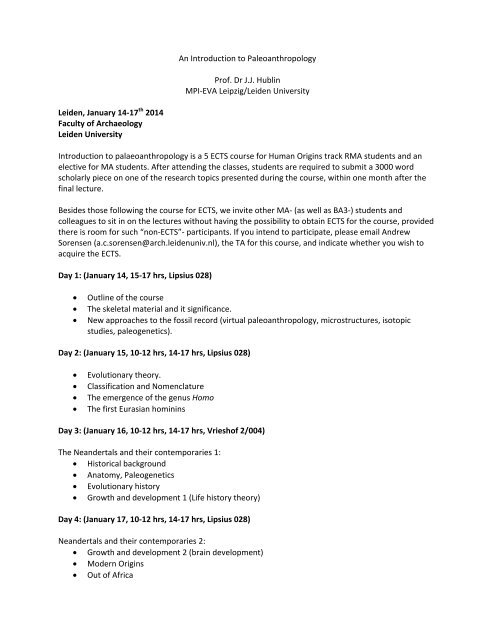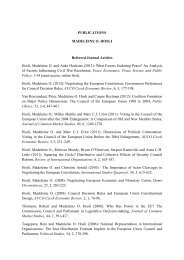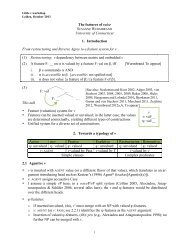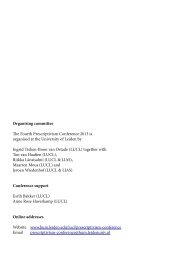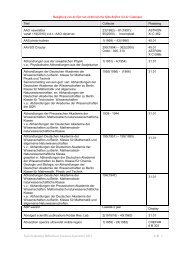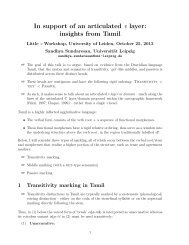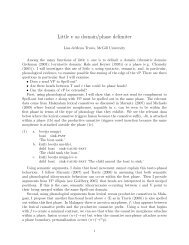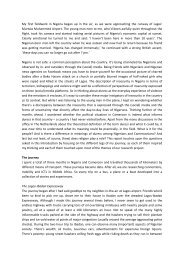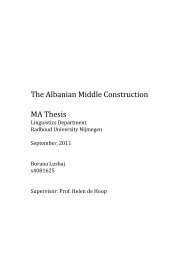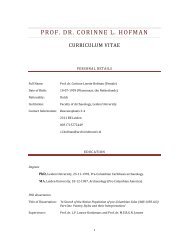Introduction to palaeoanthropology
Introduction to palaeoanthropology
Introduction to palaeoanthropology
Create successful ePaper yourself
Turn your PDF publications into a flip-book with our unique Google optimized e-Paper software.
An <strong>Introduction</strong> <strong>to</strong> Paleoanthropology<br />
Prof. Dr J.J. Hublin<br />
MPI-EVA Leipzig/Leiden University<br />
Leiden, January 14-17 th 2014<br />
Faculty of Archaeology<br />
Leiden University<br />
<strong>Introduction</strong> <strong>to</strong> <strong>palaeoanthropology</strong> is a 5 ECTS course for Human Origins track RMA students and an<br />
elective for MA students. After attending the classes, students are required <strong>to</strong> submit a 3000 word<br />
scholarly piece on one of the research <strong>to</strong>pics presented during the course, within one month after the<br />
final lecture.<br />
Besides those following the course for ECTS, we invite other MA- (as well as BA3-) students and<br />
colleagues <strong>to</strong> sit in on the lectures without having the possibility <strong>to</strong> obtain ECTS for the course, provided<br />
there is room for such “non-ECTS”- participants. If you intend <strong>to</strong> participate, please email Andrew<br />
Sorensen (a.c.sorensen@arch.leidenuniv.nl), the TA for this course, and indicate whether you wish <strong>to</strong><br />
acquire the ECTS.<br />
Day 1: (January 14, 15-17 hrs, Lipsius 028)<br />
• Outline of the course<br />
• The skeletal material and it significance.<br />
• New approaches <strong>to</strong> the fossil record (virtual paleoanthropology, microstructures, iso<strong>to</strong>pic<br />
studies, paleogenetics).<br />
Day 2: (January 15, 10-12 hrs, 14-17 hrs, Lipsius 028)<br />
• Evolutionary theory.<br />
• Classification and Nomenclature<br />
• The emergence of the genus Homo<br />
• The first Eurasian hominins<br />
Day 3: (January 16, 10-12 hrs, 14-17 hrs, Vrieshof 2/004)<br />
The Neandertals and their contemporaries 1:<br />
• His<strong>to</strong>rical background<br />
• Ana<strong>to</strong>my, Paleogenetics<br />
• Evolutionary his<strong>to</strong>ry<br />
• Growth and development 1 (Life his<strong>to</strong>ry theory)<br />
Day 4: (January 17, 10-12 hrs, 14-17 hrs, Lipsius 028)<br />
Neandertals and their contemporaries 2:<br />
• Growth and development 2 (brain development)<br />
• Modern Origins<br />
• Out of Africa
• Neandertal Extinction<br />
Required reading:<br />
Chapters 5, 6 and 8 in Richard Klein, The Human Career: Human Biological and Cultural Origins, Third<br />
Edition, University of Chicago Press, 2009, ISBN 9780226439655 .<br />
Suggested additional reading:<br />
1. Antón, S. C. and C. C. Swisher (2004) Early Dispersals of Homo from Africa. Annual Review of<br />
Anthropology 33:271-296.<br />
2. Bailey, S., Weaver, T.D. and J.-J. Hublin (2009) Who made the Aurignacian and other early Upper<br />
Paleolithic industries? Journal of Human Evolution 57:11-26.<br />
3. Bruner, E. (2010) Morphological Differences in the Parietal Lobes within the Human Genus: A<br />
Neurofunctional Perspective. Current Anthropology 51(s1): S77-S88.<br />
4. Freidline, S.E., Gunz, P., Harvati, K. and J.-J. Hublin (2012) Middle Pleis<strong>to</strong>cene human facial<br />
morphology in an evolutionary and developmental context. Journal of Human Evolution<br />
63(5):723-740.<br />
5. Froehle, A. W. and S. E. Churchill (2009) Energetic competition between Neandertals and<br />
ana<strong>to</strong>mically modern humans. PaleoAnthropology 2009(96-116).<br />
6. Gunz, P., Neubauer, S., Maureille, B. and J.-J. Hublin (2010) Brain development after birth differs<br />
between Neanderthals and modern humans. Current Biology 20:R921-R922.<br />
7. Henry, A. G., Brooks, A. S. and D. R. Piperno (2011) Microfossils in calculus demonstrate<br />
consumption of plants and cooked foods in Neanderthal diets (Shanidar III, Iraq; Spy I and II,<br />
Belgium). Proceedings of the National Academy of Sciences 108:486-491.<br />
8. Hublin, J. J. (2009) The origin of Neandertals. Proceedings of the National Academy of Sciences<br />
106:16022-16027.<br />
9. Hublin, J.-J. (2012) The earliest modern human colonization of Europe. Proceedings of the<br />
National Academy of Sciences 109(34): 13471-13472.<br />
10. Hublin, J.-J. et al. (2012) Radiocarbon dates from the Grotte du Renne and Saint-Césaire support<br />
a Neandertal origin for the Châtelperronian. Proceedings of the National Academy of Sciences<br />
109(46):18743-18748.<br />
11. Kachel, A.F., Premo, L.S. and J.-J. Hublin (2011) Modeling the effects of weaning age on length of<br />
female reproductive period - Implications for the evolution of human life his<strong>to</strong>ry. American<br />
Journal of Human Biology 23(4):479-487.<br />
12. Kaplan, H. et al. (2000) A theory of human life his<strong>to</strong>ry evolution: Diet, intelligence, and longevity.<br />
Evolutionary Anthropology 9(4): 156-185.
13. Meyer, M. et al. (2012) A High-Coverage Genome Sequence from an Archaic Denisovan<br />
Individual. Science 338(6104):222-226.<br />
14. Neubauer, S. and J.-J. Hublin (2012) The Evolution of Human Brain Development. Evolutionary<br />
Biology 39(4):568-586.<br />
15. Premo, L. S., and J.-J. Hublin (2009) Culture, population structure, and low genetic diversity in<br />
Pleis<strong>to</strong>cene hominins. Proceedings of the National Academy of Sciences 106(1):33-37.<br />
16. Richards, M. P. (2009) Stable Iso<strong>to</strong>pe Evidence for European Upper Paleolithic Human Diets, In:<br />
J.-J. Hublin and M.P. Richards (eds.),The Evolution of Hominin Diets. Integrating Approaches <strong>to</strong><br />
the Study of Palaeolithic Subsistence. Dordrecht: Springer, pp. 251-257.<br />
17. Roebroeks, W., Hublin, J.-J. and K. MacDonald (2011) Continuities and Discontinuities in<br />
Neandertal Presence: A Closer Look at Northwestern Europe. In: N.M. Ash<strong>to</strong>n, S.G. Lewis and<br />
C.B. Stringer (eds.), The Ancient Human Occupation of Britain, Developments in Quaternary<br />
Science. Amsterdam: Elsevier, pp. 113-123.<br />
18. Ruff, C. B. et al. (1997) Body mass and encephalization in Pleis<strong>to</strong>cene Homo. Nature 387: 173-<br />
176.<br />
19. Smith, T. M. et al. (2010) Dental evidence for on<strong>to</strong>genetic differences between modern humans<br />
and Neanderthals. Proceedings of the National Academy of Sciences 107:20923-20928.


